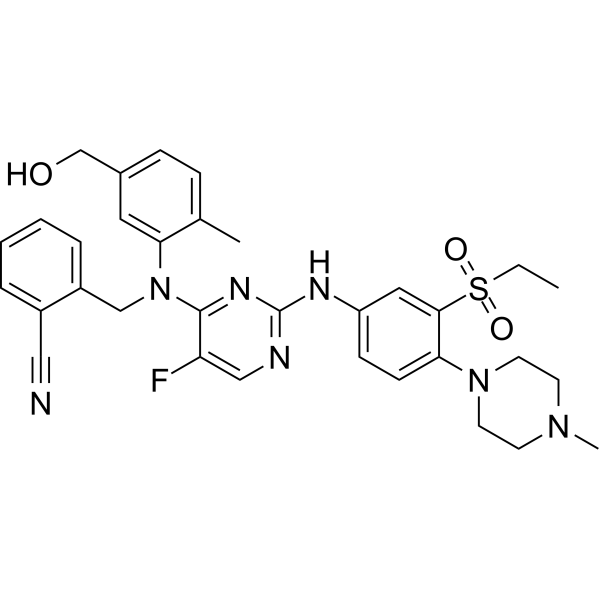
AZ13705339
CAS No. 2016806-57-6
AZ13705339( AZ-13705339 | AZ 13705339 )
Catalog No. M27853 CAS No. 2016806-57-6
AZ13705339 is a potent and selective PAK1 inhibitor with IC50 of 0.33 nM.
Purity : >98% (HPLC)
 COA
COA
 Datasheet
Datasheet
 HNMR
HNMR
 HPLC
HPLC
 MSDS
MSDS
 Handing Instructions
Handing Instructions
| Size | Price / USD | Stock | Quantity |
| 2MG | 35 | Get Quote |


|
| 5MG | 58 | Get Quote |


|
| 10MG | 88 | Get Quote |


|
| 25MG | 200 | Get Quote |


|
| 50MG | 320 | Get Quote |


|
| 100MG | 515 | Get Quote |


|
| 200MG | Get Quote | Get Quote |


|
| 500MG | Get Quote | Get Quote |


|
| 1G | Get Quote | Get Quote |


|
Biological Information
-
Product NameAZ13705339
-
NoteResearch use only, not for human use.
-
Brief DescriptionAZ13705339 is a potent and selective PAK1 inhibitor with IC50 of 0.33 nM.
-
DescriptionAZ13705339 is a potent and selective PAK1 inhibitor with IC50 of 0.33 nM.(In Vitro):AZ13705339 (300 nM) prevents Siglec-8 binding-induced eosinophil death. In Namalwa cells, AZ13705339 (1 μM) inhibits αIgM-controlled but not PMA-induced adhesion.(In Vivo):In rats, AZ13705339 (100 mg/kg, p.o.) exhibits moderate clearance and Cmax of 7.7 μM.
-
In VitroAZ13705339 (1 μM) inhibits αIgM-controlled adhesion and not PMA-induced adhesion in Namalwa cells.AZ13705339 (300 nM, 30 min) prevents Siglec-8 engagement-induced eosinophil death.
-
In VivoAZ13705339 (100 mg/kg, P.O.) has moderate clearance and oral Cmax of 7.7 μM in rats.
-
SynonymsAZ-13705339 | AZ 13705339
-
PathwayOthers
-
TargetOther Targets
-
Recptor——
-
Research Area——
-
Indication——
Chemical Information
-
CAS Number2016806-57-6
-
Formula Weight629.76
-
Molecular FormulaC33H36FN7O3S
-
Purity>98% (HPLC)
-
SolubilityIn Vitro:?DMSO : 250 mg/mL (396.98 mM)
-
SMILESCCS(=O)(=O)c1cc(Nc2ncc(F)c(n2)N(Cc2ccccc2C#N)c2cc(CO)ccc2C)ccc1N1CCN(C)CC1
-
Chemical Name——
Shipping & Storage Information
-
Storage(-20℃)
-
ShippingWith Ice Pack
-
Stability≥ 2 years
Reference
1.Andrew F Ducruet , et al. GM1485, a Nonimmunosuppressive Immunophilin Ligand, Promotes Neurofunctional Improvement and Neural Regeneration Following Stroke. J Neurosci Res. 2012 Jul;90(7):1413-23.
molnova catalog



related products
-
Pannexin - 1 Fragmen...
Pannexin - 1 Fragment (4512)
-
PCO 400
PCO 400 is an analog of comakalim that acts as a selective and potent ATP-sensitive K+ channel opener.
-
Mirificin
Puerarin has been investigated for the treatment of Alcohol Abuse.



 Cart
Cart
 sales@molnova.com
sales@molnova.com


